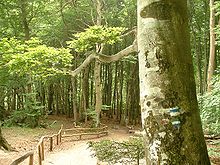| Jasmund National Park | |
|---|---|
| Nationalpark Jasmund | |
 Cliffs and coastline in the national park | |
 | |
| Location | |
| Nearest city | Sassnitz, Stralsund |
| Coordinates | 54°33′N 13°39′E / 54.550°N 13.650°E |
| Area | 30 km2 (12 sq mi) |
| Established | 12 September 1990 |
| UNESCO World Heritage Site | |
|---|---|
 The beech forest | |
| Part of | Ancient and Primeval Beech Forests of the Carpathians and Other Regions of Europe |
| Criteria | Natural: ix |
| Reference | 1133bis-011 |
| Inscription | 2011 (35th Session) |
| Area | 492.5 ha |
| Buffer zone | 2,510.5 ha |
The Jasmund National Park (German: Nationalpark Jasmund) is a nature reserve on the Jasmund peninsula, in the northeast of Rügen island in Mecklenburg-Vorpommern, Germany. It is famous for containing the largest chalk cliffs in Germany, the highest of which is Königsstuhl (German = "king's chair"), rising to 118 m (387 ft) above the Baltic Sea.[1] The highest point in the park as a whole is Pieckberg, at 161 m (528 ft) above sea level.[2] The beech forests behind the cliffs are also part of the national park.
Consisting of only 30 km2 (12 sq mi), this is the smallest national park in Germany.[1] The park was founded in September 1990 by the last government of East Germany (GDR) prior to the German reunification.[3]
On 25 June 2011 the beech forest in the park was added to the UNESCO World Heritage List as an extension of the Primeval Beech Forests of Europe site because of its undisturbed nature and its testimony to the ecological history of Europe since the last Ice Age.[4]
- ^ a b "Übersicht der Nationalparke in Deutschland" [Overview of national parks in Germany]. NABU - Naturschutzbund Deutschland e.V. (in German). Archived from the original on 31 August 2023. Retrieved 31 August 2023.
- ^ "Nationalpark Jasmund". Jasmund National Park. Archived from the original on 31 August 2023. Retrieved 31 August 2023.
- ^ "Nationalpark - Geschichte" [National Park - History]. Jasmund National Park (in German). Archived from the original on 31 August 2023. Retrieved 31 August 2023.
- ^ "Ancient and Primeval Beech Forests of the Carpathians and Other Regions of Europe". UNESCO World Heritage Centre. United Nations Educational, Scientific, and Cultural Organization. Archived from the original on 2 March 2012. Retrieved 3 September 2022.